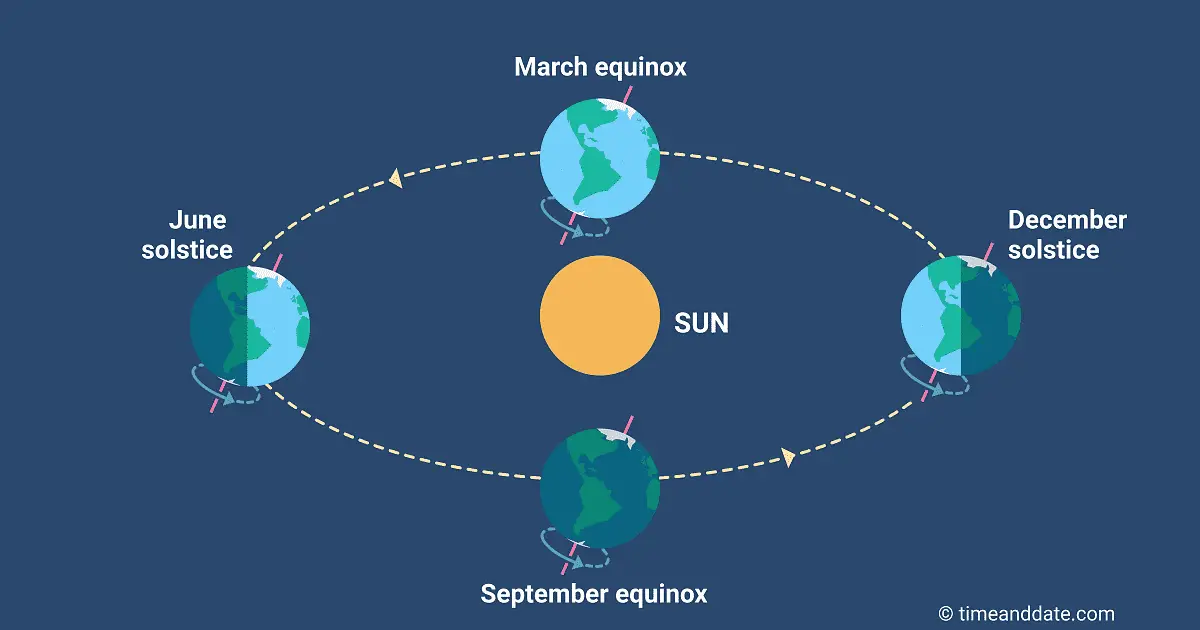
In the Southern Hemisphere, sun outages occur after the March equinox and before the September equinox. In the Northern Hemisphere, sun outages occur in the days before the March equinox and after the September equinox. Equinoctial Disruptions Satellites are vulnerable to disruptions in the days before and after an equinox. “Polar night” describes the opposite phenomenon, a time in which the sun never rises, keeping the region dark for 24-hour periods. In this way, the equinoxes in polar regions signal the slow change from “ midnight sun” to “ polar night.” “Midnight sun” describes the phenomenon in which the sun never dips below the horizon, keeping the region bathed in sunlight 24 hours a day. Polar RegionsAtmospheric refraction is most dramatic in the Arctic and Antarctic, with daylight extending about 12 hours and 16 minutes. At about 30° latitude, day is about eight minutes longer than night. Atmospheric refraction also increases the disparity in the “equinox” length of day and night. Mid-latitudesSeasonal variation increases with latitude. Equinoxes and celestial seasons generally have less impact than climate-driven patterns such as precipitation ( rainy seasons and dry seasons). As a result, areas near Earth’s Equator experience relatively constant sunlight and little equinoctial variation. Equatorial RegionsThe Equator, at 0° latitude, receives a maximum intensity of the sun’s rays all year.

Due to atmospheric refraction, we are able to see the sun minutes before it actually rises and sets. Atmospheric refraction is a result of increasing air density, which decreases the velocity of light through the air. Atmospheric refraction describes the way light seems to bend or deviate from a straight line as it passes through Earth’s atmosphere. This is largely due to atmospheric refraction. Although the equinoxes are as close to this phenomenon as happens on Earth, even during the equinoxes day and night aren’t exactly equal. (The solar terminator is the shadowed line indicating daylight and sunlight on a globe.) A true equinox would indicate 12 hours of both day and night. As its name suggests, an equinox indicates equally illuminated hemispheres, with the solar terminator equally dividing the Earth from north to south. Around December 21, the subsolar point hits the Tropic of Capricorn (23.5°S). After the September equinox, the subsolar point continues to move south as the Southern Hemisphere tilts toward the sun. This is the June solstice, after which the subsolar point begins to migrate south. Around June 21, the subsolar point hits the Tropic of Cancer, (23.5°N). After the March equinox, the subsolar point migrates north as the Northern Hemisphere tilts toward the sun. Before and after the equinox, the subsolar point migrates north or south. Only during an equinox is the Earth's 23.5° axis not tilting toward or away from the sun: the perceived center of the Sun’s disk is in the same plane as the Equator. The subsolar point is an area where the sun's rays shine perpendicular to the Earth's surface-a right angle. (The Equator, of course, is 0° latitude.) So, equinoxes are the only times of the year when the subsolar point is directly on the Equator.

Solar declination describes the latitude of the Earth where the sun is directly overhead at noon. The Science of the Equinoxes During the equinoxes, solar declination is 0°. The September equinox is the autumnal equinox in the Northern Hemisphere and the vernal in the Southern.

The March equinox is the vernal equinox in the Northern Hemisphere, and the autumnal equinox in the Southern. On Earth, there are two equinoxes every year: one around March 21 and another around September 22. Sometimes, the equinoxes are nicknamed the “ vernal equinox” (spring equinox) and the “ autumnal equinox” (fall equinox), although these have different dates in the Northern and Southern Hemispheres. The equinoxes are the only time when both the Northern and Southern Hemispheres experience roughly equal amounts of daytime and nighttime. An equinox is an event in which a planet’s subsolar point passes through its Equator.


 0 kommentar(er)
0 kommentar(er)
